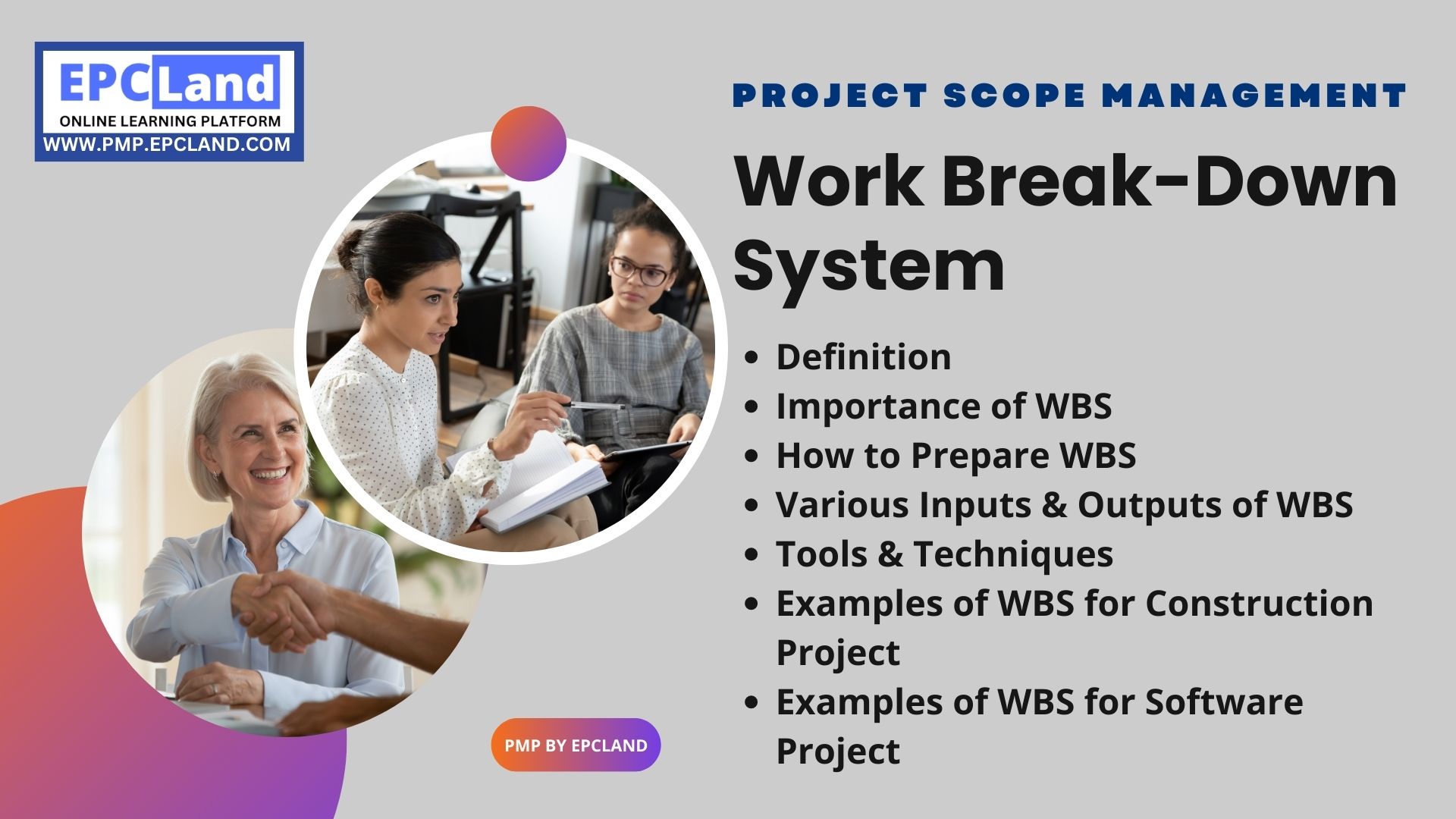A Work Breakdown Structure (WBS) is a tool that is often used in the “Define Scope” process of project management to divide the project into smaller, more manageable tasks and deliverables. The WBS is a hierarchical representation of the project’s scope, breaking down the project into smaller components that can be easily planned, executed, and controlled.
The WBS helps to ensure that all aspects of the project are identified and included in the scope statement. It is a visual representation of the project’s deliverables and helps to organize the project into manageable chunks. By breaking the project down into smaller pieces, the WBS makes it easier to identify dependencies, allocate resources, and track progress.
The WBS is often included as part of the project management plan and is used in conjunction with other tools and techniques, such as the scope statement, requirements documentation, and project charter, to define and manage the project’s scope. It is also used to develop the project schedule and budget, and to track progress throughout the project.
The WBS is a key component of project scope management and is used to help ensure that the project’s deliverables are completed on time, within budget, and to the satisfaction of the stakeholders.
Table of Contents
ToggleAttempt Quiz-1 on Work Breakdown Structure (WBS)

Time's up
Importance of Work Break Down Structure (WBS)
A Work Breakdown Structure (WBS) is an important tool in project scope management as it helps to define and organize the project’s scope in a clear and manageable way. The WBS breaks the project down into smaller, more manageable tasks and deliverables, making it easier to identify dependencies, allocate resources, and track progress.
Some key benefits of using a WBS in project scope management include:
- Clarity and structure: The WBS provides a clear and structured representation of the project’s scope, making it easier for team members and stakeholders to understand the project’s objectives and deliverables.
- Improved planning: The WBS helps to identify all of the tasks and deliverables that are required to complete the project, making it easier to develop a detailed project plan and schedule.
- Better resource allocation: By breaking the project down into smaller components, the WBS makes it easier to identify the resources that are required to complete each task and deliverable, helping to ensure that resources are used effectively and efficiently.
- Enhanced progress tracking: The WBS provides a clear and measurable way to track progress throughout the project, making it easier to identify any issues or delays and take corrective action.
- Better communication: The WBS helps to ensure that all stakeholders have a clear understanding of the project’s scope, objectives, and deliverables, which can help to improve communication and collaboration within the project team.
- Facilitation of change control: The WBS helps to facilitate change control process by making it easy to track and manage changes to the project scope.
Overall, using a WBS in project scope management can help to ensure that the project is completed on time, within budget, and to the satisfaction of the stakeholders.
How to Prepare Work Break Down Structure (WBS)
Here are some steps that can be followed to prepare a Work Breakdown Structure (WBS) in project scope management:
- Review the project charter and project management plan: The WBS should align with the project’s objectives and deliverables as outlined in the project charter and project management plan.
- Identify the project’s main deliverables: Break down the project into its main deliverables, such as products, services, or results.
- Decompose the main deliverables: Break down each main deliverable into smaller, more manageable components (i.e., sub-deliverables). Use the “100% rule” which means that the work at each level of the WBS should be fully inclusive and mutually exclusive.
- Define the work packages: The lowest level of the WBS is the work package, which is the smallest unit of work that can be scheduled and managed.
- Number and code the WBS: Assign a unique number or code to each element of the WBS to help with identification and tracking.
- Review and validate the WBS: Review the WBS with the project team and stakeholders to ensure that it is complete and accurate.
- Incorporate the WBS into the project management plan: Include the WBS in the project management plan as a tool for tracking progress and managing the project’s scope.
- Keep it updated: Review and update the WBS as needed throughout the project to reflect any changes to the project’s scope or objectives.
It’s important to note that the WBS is a living document and should be regularly reviewed and updated to reflect changes to the project’s scope or objectives. Also, it should be flexible enough to adapt to any changes that may occur during the project.
Tools & Techniques of Work Break Down Structure (WBS)
There are several tools and techniques that can be used to create and manage a Work Breakdown Structure (WBS) in project management. These include:
- Mind mapping software: This type of software allows users to create visual diagrams of the project tasks and sub-tasks in an intuitive and organized manner.
- Outline software: Outline software can be used to create a hierarchical list of the project tasks and sub-tasks, making it easy to see the structure of the project and how tasks are related.
- Spreadsheet software: Spreadsheets can be used to create a detailed list of the project tasks and sub-tasks, along with associated information such as task duration, resource requirements, and dependencies.
- Project management software: Many project management software programs include WBS functionality, allowing users to create and manage a WBS within the program.
- Expert judgment: This technique is used to gain input from subject matter experts to help identify and define the project tasks and sub-tasks.
- Decomposition: It is the process of breaking down high-level project objectives into smaller, more manageable components.
It’s important to note that the best tool or technique for creating a WBS will depend on the specific needs of the project, the team, and the organization.
Inputs of Work Break Down Structure (WBS)
- Project charter: The project charter outlines the project’s objectives, deliverables, and stakeholders, which provides a foundation for the WBS.
- Project management plan: The project management plan includes details on the project’s scope, schedule, budget, and quality management, which can inform the WBS.
- Enterprise environmental factors: The organization’s policies, procedures, and guidelines can provide context for the WBS.
- Organizational process assets: The organization’s templates, forms, and historical information can be used to develop the WBS.
Don’t Miss the 1000+ MCQ questions & hundreds of quizzes on PMP Knowledge Areas and Various important sections.
Outputs of Work Break Down Structure (WBS)
- Work Breakdown Structure: The WBS is a hierarchical representation of the project’s scope, breaking it down into smaller, more manageable components.
- WBS dictionary: The WBS dictionary is a document that provides detailed information on each element of the WBS, including the deliverable, the responsible party, and the acceptance criteria.
- Project management plan updates: The WBS may be used to update the project management plan, including the schedule and the budget.
- Project documents updates: The WBS may be used to update other project documents, such as the risk register and the requirements document.
- Deliverable: The WBS helps to ensure that all deliverables are included in the project, and that they are clearly defined and understood by all stakeholders.
- Change requests: The WBS can facilitate change control process by making it easy to track and manage changes to the project scope.
Overall, the WBS is an important tool for project scope management, as it helps to define and organize the project’s scope in a clear and manageable way, and also helps to ensure that all deliverables are included in the project and that they are clearly defined and understood by all stakeholdders
Example of Work Break Down Structure (WBS) for a construction project
Here is an example of a Work Breakdown Structure (WBS) for a construction project:
- Project management
- Project initiation
- Project planning
- Project execution
- Project monitoring and controlling
- Project closing
- Site preparation
- Site survey
- Demolition
- Excavation
- Grading
- Utilities installation
- Building construction
- Foundation
- Framing
- Roofing
- Plumbing
- Electrical
- HVAC
- Finish work
- Landscaping
- Site grading
- Irrigation
- Planting
- Walkways and hardscaping
- Closeout
- Punch list
- Final inspection
- Warranty work
Each element of the WBS is broken down into smaller, more manageable components, making it easy to track progress, assign responsibilities, and manage the project’s scope. The WBS also aligns with the project’s objectives and deliverables as outlined in the project charter and project management plan.
Attempt Quiz-2 on Work Breakdown Structure (WBS)

Time's up
Example ofWork Break Down Structure (WBS) for a construction projectSoftware
Another example of WBS in project scope management is for the development of a software application:
- Project management
- Project initiation
- Project planning
- Project execution
- Project monitoring and controlling
- Project closing
- Requirements gathering
- Business analysis
- User interviews
- User research
- Use case development
- Design
- UI/UX design
- Database design
- System design
- Security design
- Development
- Backend development
- Frontend development
- Quality assurance
- Deployment
- System integration
- User acceptance testing
- Deployment to production
- Maintenance
- Bug fixing
- Performance optimization
- Version updates
As you can see, the WBS is a hierarchical representation of the project’s scope and it’s tailored to fit the specific project’s needs and objectives. The WBS helps to break down the project into smaller, more manageable components and it is useful for tracking progress, assigning responsibilities, and managing the project’s scope.
FAQs on "Create WBS" in Project Scope Management
What is WBS in project management?
WBS stands for Work Breakdown Structure, a hierarchical decomposition of project deliverables and activities into smaller, more manageable components.
What is the purpose of creating a WBS?
The purpose of creating a WBS is to organize and define the total scope of a project, breaking it down into smaller, more manageable components to better understand, estimate, schedule and control the project.
Who is responsible for creating the WBS?
The responsibility for creating the WBS typically falls on the project manager and/or the project team, with input from stakeholders and subject matter experts as needed.
What are the steps involved in creating a WBS?
The steps involved in creating a WBS are: defining the project scope, organizing the scope into smaller components, defining and organizing the work packages, and verifying and validating the WBS.
How does a WBS help in project scope management?
A WBS helps in project scope management by clearly defining the scope of work, providing a common understanding of project deliverables, breaking down the project into smaller components to enable better planning, estimation, and control, and facilitating communication and collaboration among team members and stakeholders.
What are the best practices for creating a WBS?
The best practices for creating a WBS include involving relevant stakeholders, using a standardized WBS template, defining work packages at the right level of detail, regularly reviewing and updating the WBS, and using appropriate software tools to manage the WBS.








































